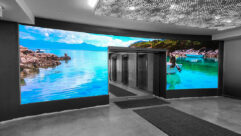LARGE-SCREEN DISPLAYS: flatter and flatter
May 1, 1999 12:00 PM,
Pete Putman
The impact of flat-matrix imaging cannot be underestimated. One majormanufacturer is discontinuing the sale of 40 inch (1 m) and largerrear-projection multisync monitors in favor of plasma display panels.Another has abandoned the projector business entirely for PDPs, and a thirdis moving away from direct-view CRT monitors to plasma. Additionally, 42inch (1.1 m) versions are priced competitively with 40 inch and largerretro projectors, and they take up less space. Even the sole 50 inch (1.3m) PDP available (Pioneer’s PDP-V501x) is cheaper than most 50 inch to 72inch (1.8 m) XGA retros.
In each projector market segment (including videowalls), virtually everyleading manufacturer has embraced Texas Instruments’ DLP imaging, from 6pound (2.7 kg) ultraportables to lightvalves exceeding 100 pounds (45 kg).LCDs are having the same impact. The installation/integration projectorsegment is getting more crowded every day with manufacturers, and severalmodels now offer SXGA (1,280×1,024) resolution.
What does this mean? For one thing, the extensive use of flat-matriximaging has simplified the installation, calibration and day-to-daymaintenance of projectors and monitors. In many cases, all that will berequired is the replacement of a projection lamp and periodic cleaning ofair filters. This simplification and market competition have combined todecrease the costs of both acquisition and ownership.
Another impact has been felt in performance. Five years ago, you would havehad to specify a large, heavy projector, ceiling brackets and detailedinstallation to achieve an RGB image of at least 1,000 lumens. Now, you canbuy a box smaller than a desktop computer that weighs 15 pounds (6.8 kg) orless to do the same thing. Interestingly enough, that behemoth from 1994could handle video, VGA graphics and maybe SVGA, if you got lucky, but nomore. Today’s brown box projectors can often sync all the way up to UXGAand yield an acceptable picture.
LCDs, DMDs and plasma have simplified the process of purchasing andinstalling large-screen displays considerably-so much that many customersare able to do a lot of the work themselves. How much knowledge does ittake to put a 2,400 lumen projector on a roll-around cart with a universalinterface/switcher? How hard is it to unbox and attach brackets to a 42inch (1.1 m) plasma monitor and hook up a few cables?
For all the convenience that flat-matrix displays provide, they do have adownside. Because LCDs, DMDs and plasma come with a pre-determinedresolution, they are not as agile as CRT engines when it comes to handlinga wide range of scan rates and input resolutions. That means products likevideo scalars and high-quality scan converters must be bundled with theseimaging technologies to get the best results.
Plasma panels have notable shortcomings in both video quality andvariable-resolution scaling. Until Sony bundled its DSC-1024 scan converterinto a 42 inch plasma last year, they were essentially useless for anythingother than wide VGA images or those measuring 852/853×480 pixels. Now, allmajor plasma manufacturers are introducing advanced scan conversion toprovide 800×600 and 1,024×768 compatibility, a given with olderCRT-equipped retro projectors.
Is this intolerable? Not really. Most multimedia monitors have insufficientdot pitch (the diameter of the CRT spot) to handle high-resolution images.Using computer monitors as a baseline, we would like to see a dot pitch of.25 mm to .28 mm when displaying 1,024×768 graphics on a 19 inch (483 mm))monitor, meaning an equivalent dot pitch of about .4 mm on a 27 inch (686mm) multiscan monitor and .55 mm on a 37 inch (940 mm) monitor.
The real world? The best 27 inch CRT multiscan monitors have a dot pitch of.6 mm, more suitable for viewing VGA and possibly SVGA. Also, 37 inchhmonitors can do between .75 mm to .8 mm, too coarse to view true XGA orSXGA. Sony’s engineers figured this out a while ago and decided thatscan-converting high-resolution images down to VGA-resolution monitors didnot turn out any worse than trying to display those images with coarse dotsizes.
Contrast this with a 42 inch plasma screen. A 4:3 aspect ratio imagedisplayed on it has a diagonal image size of 35 inches (889 mm), about thesame as a 37 inch multiscan monitor, but the 42 inch (1.1 m) plasma hascoarser resolution 1.08 mm about twice what we want to see in a monitor ofthat size. Although 50 inch plasma monitors have larger pixelcounts-typically 1,280×768 pixels the pixels are still too large; .75 mmwould be preferable.
There are three variables at work here screen size, pixel pitch and dotpitch. Even though a plasma display can show a high-resolution signal, youmay not be able to perceive all of the resolution in that signal. That willbegin to change at INFOCOMM with the introduction of higher-resolutionpanels from Sony, Sanyo, Hitachi and others. These panels will add moreconfusion to the mix, however, by using non-square pixels in both 4:3 and16:9 sizes.
Sony’s new PFM-510A1W plasma panel uses 1,024×1,024 non-square pixels, eachof which measures .9 mm by .51 mm (that scales to 16:9). The panel size,however, is unchanged with a 42 inch diagonal viewing area. Closer tooptimum, but still a little coarse. Hitachi has shown a 1,024×768 40 inchplasma panel, but its pixel pitch is closer to 1 mm. Ditto Sanyo, who alsofeatured a 1,024×1024 16:9 panel at least year’s COMDEX show.
It is unrealistic to expect that plasma pixels will become a lot smallerthan their current sizes. Given the PDP’s unbeatable combination of bigscreens and light weight, smaller pixels will not be a burning issue formanufacturers; their answer will be to make the panels larger. If you areconsidering a plasma specification, it would be wise to view the differenttypes of graphics that will be shown on the panel to see how they hold upthrough the compromises in pixel size and pitch.
Although pixel pitch is not a problem for flat-matrix technologies likeLCDs and DMDs, the display of video is definitely a headache.Unfortunately, the best video scaling circuits are found on only the mostexpensive projectors. If you are considering an LCD installation projectorand have a client who is fussy about video image quality, an externalscalar is a must.
One trick is to use an external, high-quality line doubler to feed theconverted video in as an RGB signal and let the projector scale the imageto its full resolution with its internal electronics. Even better, bypassthe projector’s scaling engine and use an outboard third-party scalar,which will give you more control over picture quality, image size/positionadjustments and custom horizontal scan and vertical refresh settings.
Higher-quality scalars also mean greater depth when it comes to colorsampling, an absolute must when playing video through plasma monitors.These panels suffer from a unique problem; the response of their individualred, green and blue cells is not always linear across a full grayscale. Youmay get more of a red color bias in areas with low gray levels. Sometimes,the effect is so pronounced that the image appears to be slightlyposterized, resembling a 256-color image and turning dark picture areaslighter.
Based on my tests on 40 inch, 42 inch and 50 inch plasma panels, anoutboard scalar is the way to go. Even inexpensive scalars make anoticeable difference in video quality on 42 inch and 50 inch plasmamonitors, reducing pixel scaling artifacts and providing a smoothergrayscale ramp from dark to light. The plasma monitor is happier as it isbeing fed an RGB signal with a corrected grayscale at the PDP’s nativeresolution.
When you demo a plasma monitor or flat-matrix projector at INFOCOMM (oranywhere else), have the dealer or rep bring along an outboard scalar sothat you can do a critical A/B comparison of video signals. True, thescalar will add to the cost of the installation, but a client spending$12,000 to $22,000 for a flat-screen television or an installationprojector will have high expectations.
We are just getting started when it comes to flat-matrix imaging. I have nodoubt that many of these technologies will completely replace traditionalCRT imaging over the next decade, provided that the problems just mentionedare thoroughly addressed. How close are we to an all-flat display era? Cometo Orlando in June, and you will get some clues.










